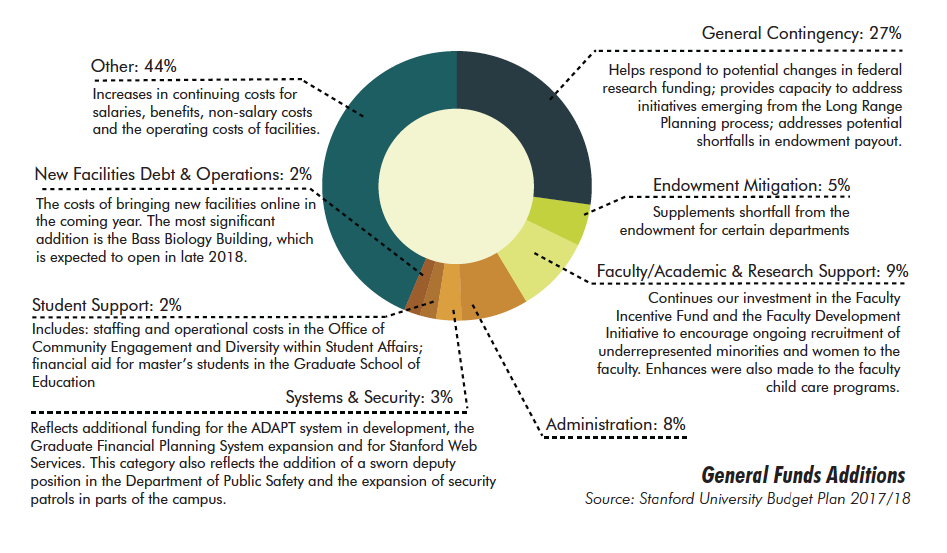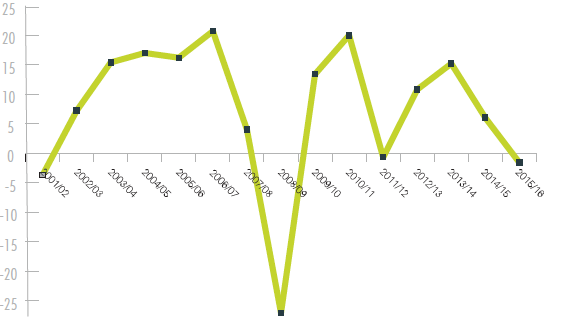“Endowment (noun): the action of endowing something or someone.” Thanks, Google.
The average Stanford student might not know what exactly the Stanford endowment does or how it differs from the annual budget. Sorry if we shook your reality there — the endowment is a pool of invested funds that help to cover University expenses in the long run, while the budget is a plan of yearly revenues and expenditures.
In this issue, The Daily seeks to clarify what the endowment is, how it feeds into this year’s budget and why it is important.
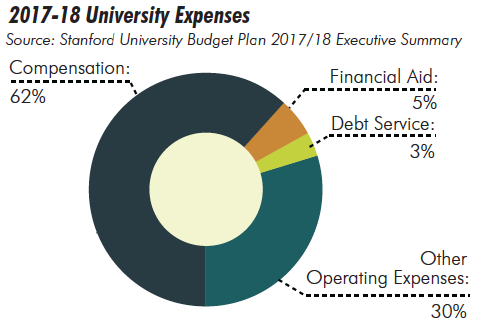
What is the endowment?
Stanford’s endowment is older than Stanford itself: The first endowment was provided by Leland and Jane Stanford in 1885, before the University opened in 1891.
“The endowment exists to support the University in perpetuity — literally forever,” said Lisa Lapin, Vice President for University Communications.
The endowment is handled by the Stanford Management Company (SMC), the University’s investments
office. The SMC summarizes the endowment goals, University portfolio and asset statuses for Stanford in a yearly report.
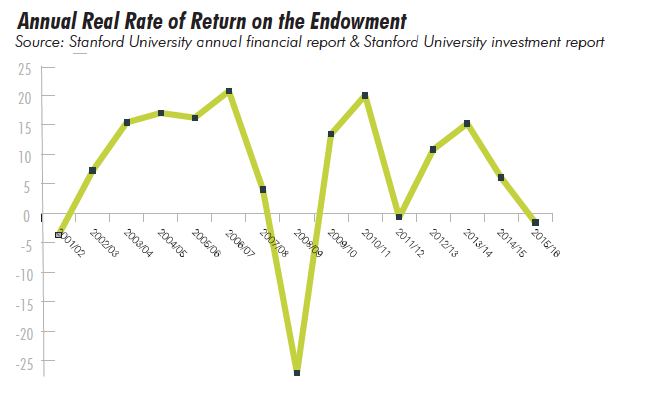
One major use of the endowment is to help keep down the cost of a Stanford education. On one hand, the endowment alone comprises around 50 percent of funding for University financial aid at any given time, according to Randy Livingston ’75 M.B.A. ’79, Vice President for Business Affairs and chief financial officer at Stanford. Since the endowment funds financial aid, it offsets tuition for the majority of Stanford students — for some students, entirely.
On the other hand, the endowment funds some University operations and pays part of faculty salaries, which means these costs don’t go into tuition either.
“Stanford’s tuition is lower than the actual cost of educating a Stanford student, in large part because the endowment subsidizes much of the total cost,” Lapin said.
According to Livingston, about 8,000 distinct funds from donors make up the endowment. This includes individual scholarships, fellowships, professorships and funds for other specific purposes. Almost every fund is tied to a purpose set by its donor — for example, a fund for an undergrad on a full scholarship can’t be used for the sociology department.
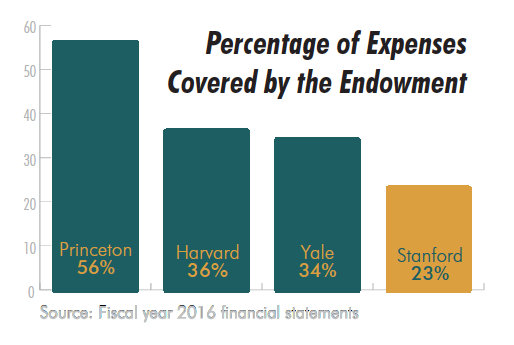
Growing the endowment
The endowment doesn’t directly fund expenditures — the returns from investing it does. SMC combines the 8,000 separate funds and invests them in the Merged Pool (MP), and part of the overall return from the MP funds the individual purposes designated by donors. The MP also includes investments from Stanford Health Care and Lucile Packard Children’s Hospital.
The other 20 percent of the endowment is represented in the value of endowed lands. Stanford has holdings on Sand Hill Road and El Camino as well as the Stanford Research Park that generate income.
After taking inflation into account, Lapin said that SMC must generate a nine-percent annual return in order to stably distribute a 5.5 percent dividend from each of the funds that make up the endowment. The required dividend is set by the Board of Trustees each year, balancing the aims of providing a steady stream of annual payout for current spending and sustaining the funds in perpetuity. They use a formula that also takes market conditions into account.
“Payout from the endowment is a critical source of funding for virtually every activity at Stanford — undergraduate and graduate education, research, arts and athletics,” said Livingston.
The endowment grew 0.8 percent to $22.4 billion in the 2015-16 fiscal year due to investment return, donations and transfers to the endowment, minus annual payout. Although investment returns surpassed the median preliminary returns of U.S. colleges and universities, overall endowment growth was less than the growth needed to support University operations after taking inflation into account. In this year’s budget, Provost Persis Drell included a $4 million endowment mitigation, or supplement to the endowment, to cover where the endowment falls short for departments that depend on endowment funds.
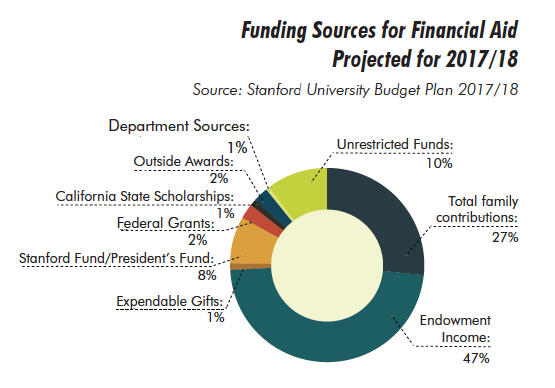
Drawing up the budget
The budget is the University’s overall plan to set money aside for spending and saving each year. Budget items range from short-term operating costs to medium-term plans such as expanding available housing to alleviate the faculty and staff housing crunch, as well as long-range planning efforts.
The 2017-18 budget plan was approved by the Board of Trustees on June 14-15, 2017. In the 2016-17 fiscal year, the payout from the endowment covered a fifth of the
annual operating budget — the same percentage contributed by health care services. In comparison, student income such as tuition comprised 15 percent of the revenue, the University reported.
As long-range planning is in development, the budget has increased less for new initiatives in comparison to previous years. The budget also includes spare funds in case of reductions in government research funding.
Areas of development include supplementary salary allocations for faculty who are struggling with housing affordability, as well as purchasing apartments and homes around Stanford to provide more affordable housing. Stanford also plans to build more graduate housing in Escondido Village.
With housing comes safety. Part of the budget has been set aside for funding the ADAPT system in development, the Graduate Financial Planning System and Stanford Web Services. These additional anticipated costs align with the addition of a sworn deputy for Public Safety and increased patrol security around parts of campus.
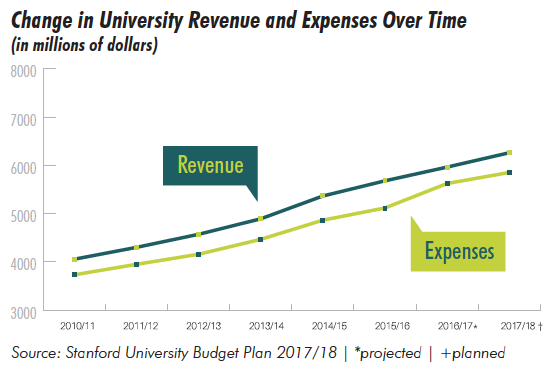
“Annual giving and the endowment is what really enables Stanford to be as great of a university that we are,” Livingston said. “It allows us to increase the value of education without going overboard on tuition.”
According to Livingston, money matters when it comes to making Stanford the place that it is — but students might argue that its allocation does too. Funding from the University is an important source of support for initiatives that promote student and faculty diversity, an issue that some student activists have drawn special attention to in the past. The 2017-18 budget includes funding for the Faculty Development Initiative, which encourages recruitment of underrepresented groups, as well as three more years of full funding for the Markaz: Resource Center. Meanwhile, community centers as well as the Diversity and First-Generation Office continue to seek increased funding to expand their programs and outreach, alongside competing needs and priorities.
Although financial jargon may not be your cup of Philz, where Stanford’s endowment comes from and where the money goes affect every aspect of academic research, student life and countless other areas, fiscal year by fiscal year.
Contact Lark Wang at larkw ‘at’ stanford.edu and Gillian Brassil at gbrassil ‘at’ stanford.edu.
